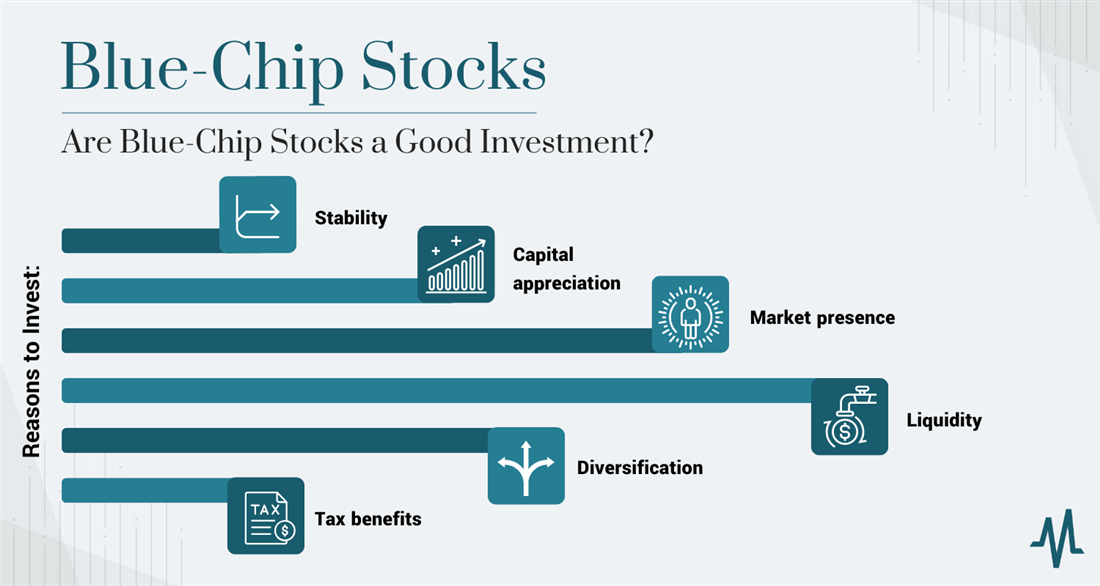Key Points
- Blue-chip stocks tend to be stocks with large market capitalization (over $10 billion).
- Like any other form of investment, you risk losing money if you invest in blue-chip stocks.
- However, if you invest wisely, you can earn a nice return on your investment.
- 5 stocks we like better than Apple
If investing were a high-stakes poker game, blue chips would be the ace up your sleeve, ensuring you have a winning strategy. Now, you might be wondering: what are blue-chip stocks? Blue chips are shares of large, well-established companies with a history of consistent performance and financial strength. These stocks are safe and reliable investments, offering stability and potential dividends to investors.
But in the unpredictable financial markets, where risk and reward often go hand-in-hand, are these market veterans indeed the gold standard for a prudent investment strategy? Or are you better off rolling the dice with riskier bets?
By the end of this article, you will be able to identify blue-chip stocks, weigh their pros and cons, understand their role in a diversified portfolio and determine whether they align with your investment goals. Let’s dive in.
Are blue-chip stocks a good investment?
In most cases, blue-chip stocks are a good investment, but the full answer lies in your personal financial goals, risk tolerance and the overall needs of your investment portfolio. They are stable and reliable and provide benefits such as regular dividend payments, market presence and liquidity.
However, they tend to be more expensive and may have less long-term growth potential than stocks issued by smaller companies.
Unveiling blue chip stocks: What sets them apart?
Blue-chip stocks aren’t the bright and flashy companies here to make a quick buck. They are the MVPs that have weathered market storms and consistently delivered solid performance. Dow Jones employee Oliver Gingold coined the term “blue chips” in the 1920s, recognizing the similarities between top-tier, reliable stocks and the blue chips used in poker games that held the highest value and represented a safe bet. The term has evolved, becoming synonymous with large, stable and financially sound companies considered the cornerstones of a well-balanced investment portfolio.
Think about the giants you often hear about, the household names that have been steering industries for decades — those are your classic blue-chip companies.
Take tech, for instance, where Apple and Microsoft stand as titans. In finance, you’ve got heavyweights like JPMorgan Chase and Bank of America. Healthcare has its stalwarts in Johnson & Johnson and Pfizer. Walk down the supermarket aisle, and you’ll find blue chips like Procter & Gamble and Coca-Cola. In the energy game, Exxon Mobil and Chevron take center stage. Retail? Walmart and The Home Depot are the go-to names.
The allure of blue-chip investments
Let’s take a look at some of the reasons investors gravitate toward high yield blue-chip stocks:
- Large market capitalization: Blue-chip stocks are associated with substantial market capitalization, often exceeding $10 billion, highlighting their significant size and influence in the market.
- Low volatility: Compared to smaller or mid-cap stocks, blue-chip stocks exhibit lower volatility, providing investors with a more stable and predictable investment experience with fewer fluctuations in value over time.
- Market leadership: Blue-chip stocks are typically market leaders within their respective industries, signifying their dominance and consistent ability to maintain a solid market position.
- Steady earnings growth: A defining characteristic of blue-chip stocks is their track record of steady earnings growth over time, showcasing their resilience in navigating economic challenges.
- Strong cash flow: Blue-chip stocks are known for their strong cash flow, indicating a robust financial foundation that enhances their ability to weather market uncertainties.
- Higher dividend yields: When compared to other investment classes, blue-chip stocks often offer a higher dividend yield, which makes them an attractive choice for investors seeking a reliable income stream.
- Greater liquidity: Because these companies are established names, their stocks tend to be more liquid than those of smaller, lesser-known companies.
Global beverage giant Coca-Cola (KO) is an excellent example of a blue-chip success story. With its iconic brand and extensive distribution network, Coca-Cola has remained dominant in the soft drink industry for decades. The company’s ability to adapt to changing consumer preferences and expand its product portfolio has contributed to its long-term success.
Another blue-chip stock is Disney (DIS). Beyond its iconic theme parks, Disney’s expansion into media networks, film studios and streaming services (Disney+) has demonstrated adaptability and resilience. The enduring appeal of Disney’s brands and characters has solidified its position as a leader in the entertainment industry.
Are blue-chip stocks immune to risk?
There will be risks no matter what you invest in, and blue-chip stocks are no exception. As with all investments, it’s important to thoroughly weigh the pros and cons before making an investment decision.
Some potential disadvantages of blue-chip stocks include:
- Price: Blue-chip stocks are generally more expensive than stocks from smaller companies since blue chips tend to be more popular and in higher demand. This means that you need a larger budget to buy them.
- Volatility: Although blue chips tend to be more stable than other stocks, they can still experience periods of volatility or decline during bear markets or recessions. This could result in losses if you don’t properly manage your portfolio during these times.
- Dividend risk: Even though many blue-chip stocks pay dividends regularly, these dividends are not guaranteed. The company’s financial health or market situation can affect the amount and frequency of dividend payments.
- Slower growth potential: Blue-chip stocks may not offer the same growth potential as stocks from smaller companies, which can have more room to grow. Therefore, you may not benefit from larger gains over the long term.
- Taxation: Any dividends you receive through blue-chip stocks are subject to taxes, which can reduce the income you get from them.
- Lack of diversification: If you only invest in blue-chip stocks, it could be difficult to diversify your investments.
- Risk of stagnation: These stocks may not offer much upside potential, which could lead to a gradual decrease in share value.
Blue-chip stocks have faced their share of challenges at various times in history. For example, investors were forced to reevaluate their risk tolerance when the recent COVID-19 pandemic caused significant volatility in travel, hospitality and energy blue-chip stocks. Many opted for a more cautious approach and adjusted their portfolios to include sectors with more pandemic-resistant characteristics, like technology and healthcare.
The subprime mortgage crisis in 2008 is another example, as both the finance and manufacturing industries faced severe economic downturns, with major names like JPMorgan Chase and Bank of America experiencing significant declines. In response, investors diversified their portfolios into defensive sectors such as healthcare and consumer staples, where companies like Johnson & Johnson and Procter & Gamble demonstrated more stability due to the essential nature of their products and services.
Macro forces at play: Understanding external influences
Macroeconomic forces can trigger substantial market shifts, which can affect blue-chip stocks in both positive and negative ways. The interconnected nature of the global economy means that external economic factors can have cascading effects on even the most robust and established companies. You must stay vigilant, adapt your strategies and diversify your portfolios to mitigate risks.
Economic indicators, like GDP growth, employment rates, and inflation, can send ripples through the market. For instance, if there’s a sudden drop in GDP, companies might tighten their belts, affecting the performance of blue-chip stocks. Investors should eye economic reports and indicators to anticipate potential impacts on their portfolios. Global events like geopolitical tensions, natural disasters or even a pandemic can disrupt the smooth sailing of blue-chip stocks.
Changes in industry trends can also be a game-changer. Suppose there’s a sudden shift in consumer preferences or a technological breakthrough. Blue-chip stocks must adapt, and those who can’t might take a hit. Think about how the rise of e-commerce impacted traditional retail, affecting blue-chip stocks in that sector.
One of the most significant market shifts in recent history was the 2008 financial crisis. The housing market bubble burst, leading to a widespread economic downturn. Blue-chip stocks, especially those in the financial sector, such as banks and insurance companies, faced significant challenges. During this time, institutions like Lehman Brothers collapsed completely, and major banks experienced substantial declines in their stock values.
The COVID-19 pandemic also had a profound impact on global markets and blue-chip stocks as lockdowns, travel restrictions and disruptions to supply chains led to a sharp economic contraction. Blue-chip stocks in the travel, hospitality and energy sectors faced significant declines. Airlines, for example, experienced a substantial drop in demand, leading to a decline in the stock prices of major players like Delta Air Lines and American Airlines. At the same time, technology-oriented blue chips, like those in the healthcare and e-commerce sectors, saw increased demand.
So, how can you stay on top of these macroeconomic influences? News outlets, financial websites and analyst reports are your best resources. Keep an ear open for any whispers of economic shifts, global happenings or changes in your blue-chip stock’s industry. Regular check-ins on reliable news platforms can serve as a radar for potential problems on the horizon.
Blue-chip performance over time
Do blue chips live up to their reputation? Typically, yes; their track records of relative stability show that blue-chip stocks function as a safer haven during bear markets due to their strong balance sheets and established market positions. In bull markets, however, where overall market sentiment is positive, and stocks generally experience upward trends, blue chips may not exhibit the same level of explosive growth as smaller, riskier counterparts. But the dividend payments from high yield blue chips can still contribute to a long-term investment strategy.
Let’s take a look at the historical performance of Apple Inc. (AAPL). Over the years, Apple has exhibited a robust performance across a spectrum of market conditions. During bull markets, Apple’s stock has often experienced steady and substantial growth, buoyed by the company’s innovative product releases, strong sales, and expanding global market share. In contrast, Apple has demonstrated remarkable resilience during bear markets, with its stock holding relatively firm compared to its more volatile counterparts.
The company’s ability to weather economic downturns is attributed to its diversified product portfolio, strong brand loyalty and consistent revenue streams. In addition, Apple’s stock has been influenced by interest rate changes, showing sensitivity to shifts in macroeconomic factors. The release of new products has consistently acted as a catalyst for positive stock movements, illustrating the market’s responsiveness to Apple’s innovations. Long-term trends reveal a remarkable appreciation in Apple’s stock value, showcasing its capacity for sustained growth. As Apple operates in the ever-evolving technology sector, its stock performance is intricately linked to industry trends, global events and the competitive landscape.
Strategies for crafting a portfolio with blue chips
Adapting your investment strategy in response to market evolution involves balancing staying committed to long-term goals and being flexible enough to make subtle adjustments when the market shifts. So, how do you create a well-balanced portfolio with blue-chip stocks?
- Define your investment goals and risk tolerance: Having a handle on your financial goals – wealth accumulation, income generation or a combination of both – is the first step in determining how many blue-chip stocks you want in your portfolio.
- Diversify across sectors: When you diversify your portfolio, you’re minimizing risk and optimizing the potential for steady, long-term gains. Spreading your investments across blue-chip stocks in technology, healthcare, finance, consumer goods, and energy provides sector diversification. Choosing blue chips with varying market capitalizations can enhance the resilience of your portfolio, as large-cap stocks offer stability. In contrast, mid-cap and small-cap blue chips may provide growth opportunities.
- Evaluate dividend-paying stocks: Because dividend payments can contribute to your income stream and provide a cushion during market downturns, you should prioritize blue-chip stocks with a history of dividend growth and payment.
- Assess financial health and stability: Focus on blue-chip stocks with robust balance sheets, manageable debt levels, a history of dividend payments and consistent revenue and earnings growth over time. Companies with sound financial health also typically have a competitive edge in their industry, strong brand recognition and a track record of innovation.
- Review management and corporate governance: A competent and transparent leadership team is crucial for sustained success, and companies with sound management practices are likely to make better strategic decisions.
- Monitor economic indicators: Monitor market trends, assessing the ebb and flow of stock prices, trading volumes and volatility. Pay attention to broader economic indicators such as interest rates, inflation, and GDP growth, as they can significantly influence market dynamics. Technical indicators like moving averages and relative strength can offer insights into a stock’s momentum. Additionally, heed qualitative factors such as news, industry developments and geopolitical events that might sway market sentiment.
- Regularly reassess and rebalance: Periodically review your portfolio to ensure it aligns with your investment goals. When necessary, rebalance by selling over-performing stocks and reinvesting in underperforming ones to maintain your desired asset allocation.
- Know when to buy, hold or sell: Continuously educate yourself about the companies in your portfolio and market trends. Regularly review earnings reports, news, and industry developments to stay abreast of potential shifts in the market. Consider buying during market downturns when these blue-chips stocks are on sale or post-earnings reports when short-term volatility might present entry points. Holding onto blue chips long-term can offer stability, especially during turbulent market conditions. If there’s a fundamental shift or overvaluation, selling may be prudent. With blue-chips, making small adjustments rather than abrupt changes is typically better since the market is volatile and unpredictable.
- Adopt a Long-term perspective: Blue-chip stocks are often best suited for long-term investors. Resist the temptation to react to short-term market fluctuations and focus on the fundamental strength of your chosen companies. A long-term perspective can help you ride out market volatility.
Consider the pros and cons of investing in blue chips
Now that you understand the answer to “What is a blue chip stock?”, consider the pros and cons on your own.
While riskier plays may tempt you with the potential of greater rewards, the enduring appeal of blue chips is their ability to weather market volatility and deliver consistent returns. Much like a royal flush in poker, blue-chip stocks can be the winning hand that secures your financial victory over the long term. Blue chips aren’t just a safe bet but the cornerstone of a resilient and well-balanced investment strategy.
Before you consider Apple, you’ll want to hear this.
MarketBeat keeps track of Wall Street’s top-rated and best performing research analysts and the stocks they recommend to their clients on a daily basis. MarketBeat has identified the five stocks that top analysts are quietly whispering to their clients to buy now before the broader market catches on… and Apple wasn’t on the list.
While Apple currently has a “Moderate Buy” rating among analysts, top-rated analysts believe these five stocks are better buys.
View The Five Stocks Here

Click the link below and we’ll send you MarketBeat’s list of the 10 best stocks to own in 2024 and why they should be in your portfolio.
Get This Free Report

